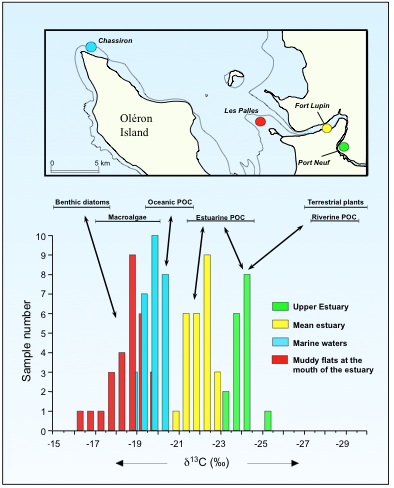Richard Pierre
- Status : Honoraire/émérite
- pierre.richard01*at*univ-lr.fr
- Resume and publications
- Tél. : +33 (O)5 46 50 76 61
Senior Researcher, Emeritus Director
CNRS
Research section : 20
CNRS Institute : INEE
Keywords : Stable isotope ecology, coastal ecosystems, food webs, organic matter, microphytobenthos, continental inputs, contaminant transfers
Research topics
Stable isotope ecology in coastal ecosystems
The stable isotope methodologies applied to the intertidal soft-bottom systems like the Pertuis Charentais have enabled understanding their present structure and functioning, and have demonstrated that benthic primary sources, and particularly the microphytobenthos, have a major role in supporting their food webs.
The typologies of the primary producers, of the food webs they support, and the ecosystem services they provide, are largely driven by the nature of the soft-bottom habitats. The increasing pressures due to the climate change or human impact upon these habitats are strongly affecting the sedimentary environment, thus rising questions about their evolution.
Analyzing the functioning of past food webs in relation to coastline changes due to sea-level changes or human activities may thus give clues about the future of littoral ecosystems.

δ13C of Crassostrea gigas oysters and of the trophic resources from land to ocean in Marennes-Oléron bay (from Riera & Richard, Estuarine, Coastal & Shelf Science, 1996, 42 : 347-360)
In this work, carbon stable isotope measurements demonstrated for the first time the prominent role of the microphytobenthos (MPB) as trophic resource of oysters, since nitrogen stable isotope data showed that macroalgae were not significantly contributing to oyster diet.
A same MPB role was later found for most deposit feeders and other suspension feeders, in numerous intertidal muddy or sandy-muddy environments.
Last publications representative of the research activity :
- Raimonet M., Guillou G., Mornet F., Richard P., 2013. Macroalgae δ15N values in well-mixed estuaries : Indicator of anthropogenic nitrogen input or macroalgae metabolism ? Estuar. Coast. Shelf Sci., 119, 126-138
- Wang Y., Liu D., Richard P., Li X., 2013. A geochemical record of environmental changes in sediments from Sishili Bay, northern Yellow Sea, China: Anthropogenic influence on organic matter sources and composition over the last 100 years. Mar. Poll. Bull., 77, 227-236
- Masbou J., Point D., Sonke J.E , Frappart F., Perrot V., Amouroux D., Richard P., Becker P.R., 2015. Hg stable isotope time trend in ringed seal registers decreasing sea ice cover in the Alaskan Arctic. Environ. Sci. Technol., 49, 8977–8985
- Marchais V., Richard J., Jolivet A., Chauvaud L., Flye Ste-Marie J., Jean F., Richard P., Clavier J., 2015. Coupling experimental and field-based approaches to decipher carbon sources in the shell of the great scallop, Pecten maximus (L.). Geochim. Cosmochim. Acta, 168, 58-69
- Liu D., Li X., Emeis K.-C., Wang Y., Richard P., 2015. Distribution and sources of organic matter in surface sediments from adjacent sea of the Yellow River Estuary, China. Estuar. Coast. Shelf Sci., 165, 128-136
- Le Bourg B., Banaru D., Saraux C., Nowaczyk A., Le Luherne E., Jadaud A., Bigot J.L., Richard P., 2015. Trophic niche overlap of sprat and commercial small pelagic teleosts in the Gulf of Lions (NW Mediterranean Sea). J. Sea Res., 103, 138-146
- Masbou J., Point D., Guillou G., Sonke J.E., Richard P., Lebreton B., 2015. Carbon stable isotope analysis of methylmercury toxin in biological materials by gas chromatography isotope ratio mass spectrometry. Anal. Chem., 87 : 11732-11738
- Wang Y., Liu D., Richard P., Di B., 2016. Selection of effective macroalgal species and tracing nitrogen sources on the different part of Yantai coast, China indicated by macroalgal δ15N values. Sci. Tot. Environ., 542, 306-31
- Zwolicki A., Zmudczyńska-Skarbek K., Richard P., Stempniewicz L., 2016. Importance of marine derived nutrients supplied by planktivorous seabirds to high Arctic tundra plant communities. PLoS ONE, 11(5) : 0154950 doi:10.1371/journal.pone.0154950
- Liu D., Peng Y., Keesing J.K., Wang Y., Richard P., 2016. Paleo-ecological analysis to assess long-term environmental effect of pearl farming in Western Australia. Mar. Ecol. Progr. Ser. (sous presse) doi 10.3354/meps11740





